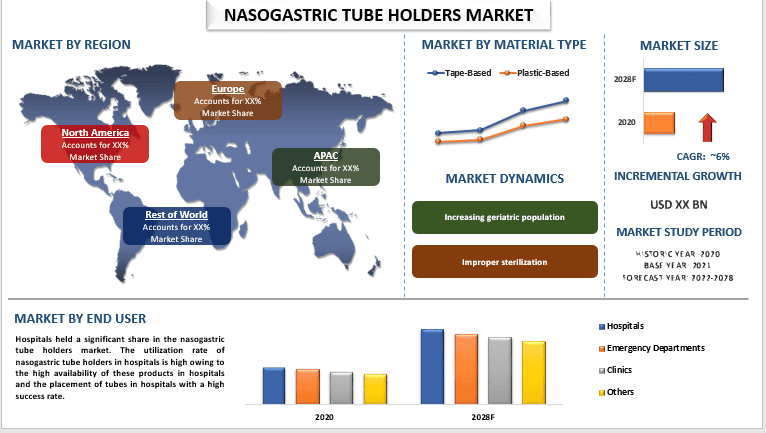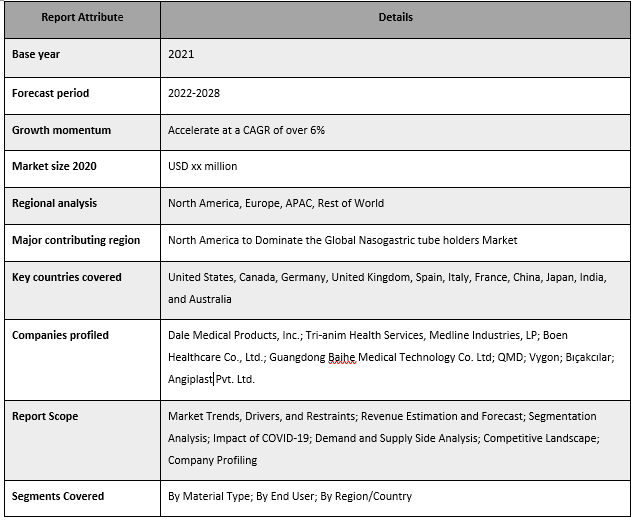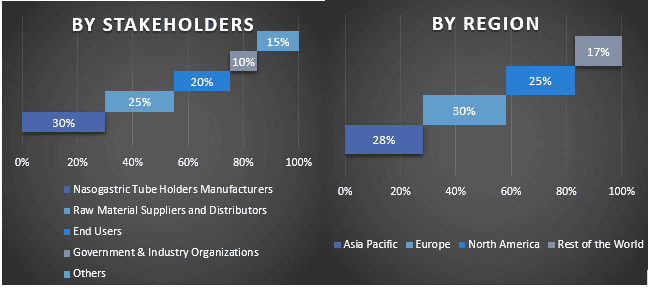- Home
- About Us
- Industry
- Services
- Reading
- Contact Us
Nasogastric Tube Holders Market: Current Analysis and Forecast (2022-2028)
Emphasis on Material Type (Tape-Based, Plastic-Based); End User (Hospitals, Emergency Departments, Clinics, Others); and Region/Country

Global Nasogastric Tube Holders Market is expected to grow at a significant rate of around 6% during the forecast period 2022-2028. Nasogastric tube holders allow safe and comfortable positioning of the enteral tube. Prevents displacement or dislodgement of the tubes and complications. Reduces skin irritation, erosion, or necrosis due to pressure or humidity injuries. The tube can be used to offer vital nutritional and pharmaceutical support to sick individuals as well as evacuate the contents of the stomach. Babies that are premature or ill have a restricted quantity of nutrients and energy. In these critical situations, the nasogastric tubes (NG) supply nutrition, and medical care. The NG tube holders rise in demand due to the increasing awareness about the irritation and inconvenience caused using nasogastric tubes. Thus, the growing focus and investment of key stakeholders in the research and development of technologically advanced nasogastric tube holders is further expected to support market growth. For instance, in May 2021, QMD, a subsidiary of Q Holding Company, expanded its enteral feeding portfolio with the addition of nasogastric tubes to the Degania enteral feeding product family. This product range includes a number of pediatric and adult designs along with enhanced patient safety.
Dale Medical Products, Inc.; Tri-anim Health Services, Medline Industries, LP; Boen Healthcare Co., Ltd.; Guangdong Baihe Medical Technology Co. Ltd; QMD; Vygon; Bıçakcılar; Angiplast Pvt. Ltd. are some of the key players in the market. Several M&As along with partnerships have been undertaken by these players to facilitate customers with hi-tech and innovative products/technologies.
Insights Presented in the Report
“Amongst material type, tape-based is expected to grow with a significant CAGR during the forecast period”
Based on material type, the market is segmented into tape-based, and plastic-based. Among these, tape-based held a significant share of the market in 2020. Most nasogastric tube holders now in use are tape-based. To handle nasogastric feeding and aspiration tubes. The holder has a skin-friendly adhesive that sticks to the skin of the nose fast and easily, which makes it superior to tape and other adhesive-backed holders.
“Amongst end user, the clinics are expected to grow with a significant CAGR during the forecast period.”
On the basis of end users, the market is categorized into hospitals, emergency departments, clinics, and others. Among these, clinics are expected to grow with a significant CAGR during the forecast period. This is mainly due to the nasogastric tube holders are used in clinics or in various medical fields for the prevention of infections and for safety measures to meet medical standards and have wide applications in the healthcare industry.
Nasogastric Tube Holders Market Report Coverage

“North America held a significant share in the market”
In 2020, North America held a significant share of the global nasogastric tube holder market. This is mainly attributed to the rise in preterm births in the United States. As per the CDC, in 2021, preterm birth affected about 1 of every 10 infants born in the United States. The preterm birth rate rose 4% in 2021, from 10.1% in 2020 to 10.5% in 2021. The sector will continue to expand as novel nasogastric tube intubation techniques in sick and preterm babies for the supply of nutrition and medications. In addition, the growing older patient population and advanced healthcare infrastructure will boost the growth of the nasogastric tube holder market in the United States over the next few years.
Reasons to buy this report:
- The study includes market sizing and forecasting analysis validated by authenticated key industry experts.
- The report presents a quick review of overall industry performance at one glance.
- The report covers an in-depth analysis of prominent industry peers with a primary focus on key business financials, product portfolio, expansion strategies, and recent developments.
- Detailed examination of drivers, restraints, key trends, and opportunities prevailing in the industry.
- The study comprehensively covers the market across different segments.
- Deep dive regional level analysis of the industry.
Customization Options:
The global nasogastric tube holders market can further be customized as per the requirement or any other market segment. Besides this, UMI understands that you may have your own business needs, hence feel free to connect with us to get a report that completely suits your requirements.
Table of Content
Research Methodology for the Nasogastric Tube Holders Market Analysis (2022-2028)
Analyzing the historical market, estimating the current market, and forecasting the future market of the global nasogastric tube holders market were the three major steps undertaken to create and analyze the adoption of nasogastric tube holders in major regions globally. Exhaustive secondary research was conducted to collect the historical market numbers and estimate the current market size. Secondly, to validate these insights, numerous findings and assumptions were taken into consideration. Moreover, exhaustive primary interviews were also conducted, with industry experts across the value chain of the global nasogastric tube holders market. Post assumption and validation of market numbers through primary interviews, we employed a top-down/bottom-up approach to forecasting the complete market size. Thereafter, market breakdown and data triangulation methods were adopted to estimate and analyze the market size of segments and sub-segments of the industry pertains to. Detailed methodology is explained below:
Analysis of Historical Market Size
Step 1: In-Depth Study of Secondary Sources:
Detail secondary study was conducted to obtain the historical market size of the nasogastric tube holders market through company internal sources such as annual reports & financial statements, performance presentations, press releases, etc., and external sources including journals, news & articles, government publications, competitor publications, sector reports, third-party database, and other credible publications.
Step 2: Market Segmentation:
After obtaining the historical market size of the nasogastric tube holders market, we conducted a detailed secondary analysis to gather historical market insights and share for different segments & sub-segments for major regions. Major segments are included in the report as material type and end user. Further country-level analyses were conducted to evaluate the overall adoption of testing models in that region.
Step 3: Factor Analysis:
After acquiring the historical market size of different segments and sub-segments, we conducted a detailed factor analysis to estimate the current market size of the nasogastric tube holders market. Further, we conducted factor analysis using dependent and independent variables such as various material type and end user of nasogastric tube holders. A thorough analysis was conducted for demand and supply-side scenarios considering top partnerships, mergers and acquisitions, business expansion, and product launches in the nasogastric tube holders market sector across the globe.
Current Market Size Estimate & Forecast
Current Market Sizing: Based on actionable insights from the above 3 steps, we arrived at the current market size, key players in the global nasogastric tube holders market, and market shares of the segments. All the required percentage shares split, and market breakdowns were determined using the above-mentioned secondary approach and were verified through primary interviews.
Estimation & Forecasting: For market estimation and forecast, weights were assigned to different factors including drivers & trends, restraints, and opportunities available for the stakeholders. After analyzing these factors, relevant forecasting techniques i.e., the top-down/bottom-up approach were applied to arrive at the market forecast for 2028 for different segments and sub-segments across the major markets globally. The research methodology adopted to estimate the market size encompasses:
- The industry’s market size, in terms of revenue (USD) and the adoption rate of the nasogastric tube holders market across the major markets domestically
- All percentage shares, splits, and breakdowns of market segments and sub-segments
- Key players in the global nasogastric tube holders market in terms of products offered. Also, the growth strategies adopted by these players to compete in the fast-growing market
Market Size and Share Validation
Primary Research: In-depth interviews were conducted with the Key Opinion Leaders (KOLs) including Top Level Executives (CXO/VPs, Sales Head, Marketing Head, Operational Head, Regional Head, Country Head, etc.) across major regions. Primary research findings were then summarized, and statistical analysis was performed to prove the stated hypothesis. Inputs from primary research were consolidated with secondary findings, hence turning information into actionable insights.
Split of Primary Participants in Different Regions

Market Engineering
The data triangulation technique was employed to complete the overall market estimation and to arrive at precise statistical numbers for each segment and sub-segment of the global nasogastric tube holders market. Data was split into several segments & sub-segments post studying various parameters and trends in the areas of material type and end user in the global nasogastric tube holders market.
The main objective of the Global Nasogastric tube holders Market Study
The current & future market trends of the global nasogastric tube holders market were pinpointed in the study. Investors can gain strategic insights to base their discretion for investments on the qualitative and quantitative analysis performed in the study. Current and future market trends determined the overall attractiveness of the market at a regional level, providing a platform for the industrial participant to exploit the untapped market to benefit from a first-mover advantage. Other quantitative goals of the studies include:
- Analyze the current and forecast market size of the nasogastric tube holders market in terms of value (USD). Also, analyze the current and forecast market size of different segments and sub-segments
- Segments in the study include areas of material type and end user.
- Define and analysis of the regulatory framework for the nasogastric tube holders
- Analyze the value chain involved with the presence of various intermediaries, along with analyzing customer and competitor behaviors of the industry.
- Analyze the current and forecast market size of the nasogastric tube holders market for the major region.
- Major countries of regions studied in the report include Asia Pacific, Europe, North America, and the Rest of the World.
- Company profiles of the nasogastric tube holders market and the growth strategies adopted by the market players to sustain in the fast-growing market.
- Deep dive regional level analysis of the industry
Related Reports
Customers who bought this item also bought










